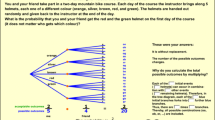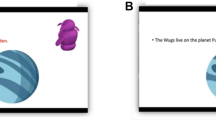Abstract
This article describes a statistical integration of findings from 74 studies of visualbased college teaching. In the typical study, students learned slightly more from visual-based instruction than from conventional teaching. In the typical study, visual-based instruction had no special effect on course completion, student attitudes, or the correlation between aptitude and achievement. Students were equally likely to complete visual-based and conventional classes; their attitudes toward the two kinds of classes were very similar; and aptitude played a strong role in determining student achievement in each kind of class.
Similar content being viewed by others
References
Biglan, A. The characteristics of subject matter in different academic areas,Journal of Applied Psychology, 1973,58, 195–203.
Bracht, G. H., & Glass, G. V. The external validity of experiments.American Educational Research Journal, 1968,5, 437–474.
Campbell, D. T., & Stanley, J. C. Experimental and quasi-experimental designs for research on teaching. In N. L. Gage (Ed.),Handbook of research on teaching. Chicago: Rand-McNally, 1963.
Chu, G. C., & Schramm, W.Learning from television: What the research says. Stanford, Calif.: Institute for Communication Research, 1967.
Cohen, J.Statistical power analysis for the behavioral sciences (Rev. ed.). New York: Academic Press, 1977.
Dubin, R., & Hedley, R. A.The medium may be related to the message: College instruction by TV. Eugene, Oreg.: University of Oregon Press, 1969.
Glass, G. V. Primary, secondary, and metaanalysis of research.Educational Researcher, 1976,5, 3–8.
Holmes, P. D., Jr.Television research in the teaching-learning process. Detroit, Mich.: Wayne State University, 1959.
Kulik, J. A., Cohen, P. A., & Ebeling, B. J. Effectiveness of programmed instruction in higher education: A meta-analysis of findings.Educational Evaluation and Policy Analysis, 1980, 2(6), 51–64.
Kulik, J. A., Kulik, C.-L. C., & Cohen, P. A. A meta-analysis of outcome studies of Kelleŕs personalized system of instruction.American Psychologist, 1979,34, 307–318. (a)
Kulik, J. A., Kulik, C.-L. C., & Cohen, P. A. Research on audiotutorial instruction: A meta-analysis of comparative studies.Research in Higher Education, 1979,11, 321–340. (b)
Kulik, J. A., Kulik, C.-L. C., & Cohen, P. A. Effectiveness of computer-based college teaching: A meta-analysis of findings.Review of Educational Research, 1980,50, 525–544.
Kumata, H.An inventory of instructional television research. Ann Arbor, Mich.: Educational Television and Radio Center, 1956.
McGaw, B., & Glass, G. V. Choice of the metric for effect size in meta-analysis.American Educational Research Journal, 1980,17, 325–337.
Niven, H. F., Jr.Instructional television as a medium of teaching in higher education. Columbus, Ohio: Ohio State University, 1958.
Norberg, K. D. The first of the Title VII reports: A Review.AV Communication Review, 1961,9 (4), 5–13.
Reid, J. C., & MacLennon, D. W.Research in instructional television and film. Washington, DC: U.S. Government Printing Office, 1967.
Schramm, W. L.The research on programmed instruction. Stanford, Calif.: Institute for Communication Research, Stanford University, 1962.
Stickell, D. W.A critical review of the methodology and results of research comparing televised and face-to-face instruction. Doctoral dissertation, The Pennsylvania State University, 1963. (University Microfilms No. 64-1419)
Author information
Authors and Affiliations
Additional information
This study was supported by National Science Foundation Grant SED 77-18566.
Rights and permissions
About this article
Cite this article
Cohen, P.A., Ebeling, B.J. & Kulik, J.A. A meta-analysis of outcome studies of visual-based instruction. ECTJ 29, 26–36 (1981). https://doi.org/10.1007/BF02765190
Issue Date:
DOI: https://doi.org/10.1007/BF02765190




